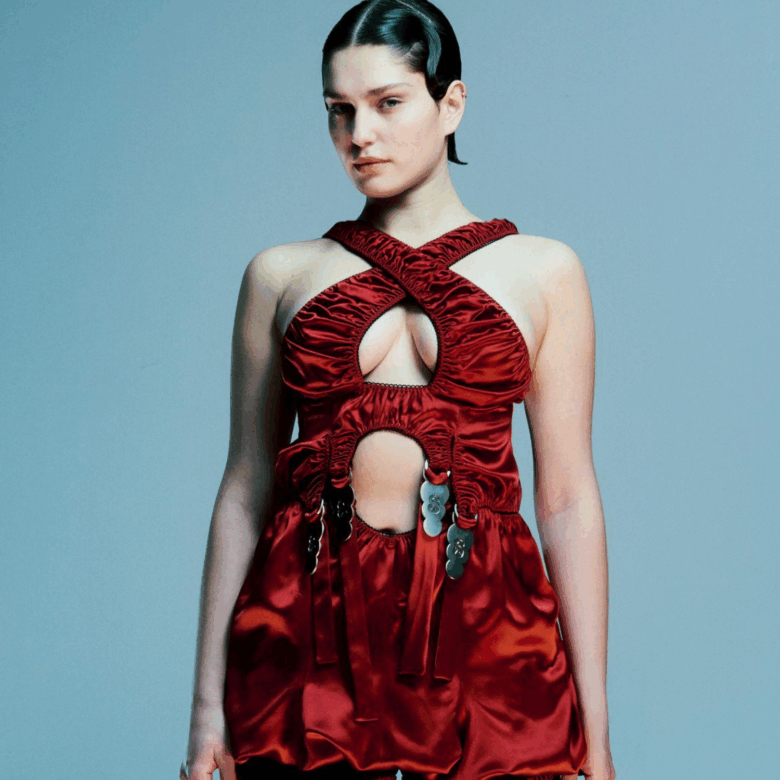This London exhibition is a one-stop shop for all things pleasure

Apparently, May is international masturbation month (if that’s a real thing) and what better way to celebrate than with an exhibition devoted to female pleasure? ‘PLEASURES’, which is currently on show at the Shoreditch Modern, features the work of six female artists and their takes on different forms of gratification — sensual or otherwise. Exhibiting in collaboration with Women of the Wick, a feminist art media born in Hackney Wick, East London, the expo is an extension of the ‘PLEASURE’ issue of their print magazine. In addition to the six talented artists, hand-picked by curators Sara Kärpänen and Anaïs Masetti, the expo brings together photography, sculpting, painting and even tufting, meaning the walls of the gallery are as varied as the artists’ interpretations of the theme. There’s a vibrant, tufted rug featuring a woman chilling at home in her knickers, a hand sculpture that’s sexy and sapphic in equal measure, as well as some slightly more on-the-nose items like a delicate porcelain butt plug. What ties all these iterations of pleasure together, though, is their sheer un-apologeticness. Whether referencing sexuality, queerness or more ambiguous forms of indulgence, each piece of art is an ode to womanhood as much as the artist’s own journey of self-discovery. Adele Brydes, Margaux Carpentier, Cat Håland, Ania Kann, Olivia Strange and Daisy Tortuga tell HUNGER how their creations speak to the notion of pleasure…
Adele Brydges, sensual alchemist and artist
Growing up in a Catholic family, the demonisation of women’s sexuality and self-pleasure was something I really rebelled against. However, it was only after leaving a very damaging four-year relationship, where I’d totally lost my sense of self, my connection with my body and my joy, that I wanted to create beautiful pleasure tools that helped me to release that shame and stigma around masturbation. In the ‘PLEASURES’ exhibition, I’ve included some ceramic plates that are a kind of homage to my grandmother, who collected functional ceramics like plates and jugs, but displayed them as decorative pieces. One of them reads, ‘Live Deliciously’, which acts as a reminder to live a pleasure-filled life, while the one I’ve entitled ‘Amrita’ shows a hand swirled in female fluids. ‘Amrita’ is the Sanskrit word for both ‘nectar’ and ‘immortal’, so I feel it’s reflective of something sacred and potent. My ‘Thalo’ porcelain and marble anal pleasure tool is also on display. Anal is still so taboo, so I really wanted to initiate a conversation around that with this piece. There’s also my ‘In Bloom’ porcelain phallus, inspired by Japanese shunga drawings. Shunga is very obscene but very beautiful, and I love marrying these two aspects in my work. Lastly, there’s the ‘Ōya’ posture collar. This takes a very feminine approach to bondage wear, which is classically quite masculine in style, so it subverts tradition. All these pieces celebrate pleasure and empowerment, and encourage the viewer to explore their own relationship with desire, as well as to question their expectation of what pleasure tools should look like. Creating these objects has not only allowed me to accept, but to celebrate the most repressed parts of myself — it’s been my most powerful tool for healing and self-acceptance.



Margaux Carpentier, painter and sculptor
While I try not to overthink my paintings and sculptures, my feelings are what ignite each of my pieces. And, while my work comes from within myself, it’s not only about me — I want my art to be easily relatable. That said, I think all my pieces transpire a female energy, even when I’m drawing men or non-binary people. And sexuality definitely plays a part in that. To me, sexuality is woven into everything. It’s life, death, pleasure and pain, and these are all things my work encompasses. Though certain pieces were selected for this exhibition, I think most of my pieces could have ‘Pleasure’, in all its ambivalence, as a title. I just want my work to be seen in a unique way by each viewer, and give them the freedom to feel what they feel and take whatever they need away from it.

Cat Håland, photographer
The work I’m showing at ‘PLEASURES’ actually comes from an exhibition I did last year called ‘What I Want’, which I created in collaboration with my best friend, Anna Michell, who’s a painter. It was around the theme of female desire, agency and shedding shame. So, I created a series called ‘Unapologetic’, which is a candid gaze on sexuality for that. The woman in the shots, Reed Amber, isn’t posed — she’s just enjoying an indulgent night in in her own house, with a drink and a book and a dildo, not giving a fuck. I’m just there to capture it. I also didn’t want a model. I wanted someone who lives the message I’m trying to portray, so, as a sex worker and educator, Reed was perfect. She’s not trying to look hot, she’s just fixing the straps on her legs and stuff, while I snap away. I also have another series called ‘Wet Dreams’, which I created because I wanted to see how I could capture pleasure and desire without anything physical. So, I just used lube on acetate sheets to create something drippy and sexy and made it colourful with gel lights. I find it really interesting to see how I can create something tactile through photography. ‘PLEASURES’ includes two pictures from ‘Unapologetic’ and one from ‘Wet Dreams’. I think women feel a lot of shame from other people around sex and I just wanted these images to show how fun it can be when we let go of that.



Ania Kann, ceramicist
I find that working with clay offers boundless potentials for crafting unique stories. In ‘PLEASURES’, I include ‘The Chainmail’, a clay sculpture that, like clay, represents resilience and vulnerability at the same time. It’s sturdy, yet fluid and invites viewers to shape their own interpretation of its sensual movements. For me, chains symbolise the innate strength and resilience and femininity, as well as sensuality. Chains have also been seen as a sexual symbol for a long time. They represent power, restraint and exploration, especially in contexts such as BDSM. Creating the chainmail pattern demands a tactile form of focus, so it fosters a deep connection with my own body and senses while I’m working. I’m also a perfectionist, so I have to learn to embrace the unpredictable nature of my medium — clay sometimes yields to the touch and other times resists. These creations teach me self control and to find beauty in imperfection. By exploring themes like chains in my work, I want to create an open dialogue about power dynamics within sex, and encourage people to embrace their desires without shame. It’s all part of a journey towards acceptance and a more inclusive, sex-positive culture.


Olivia Strange, sculptor and painter
I first started sculpting hands as a way of offering an alternative lens for seeing the body in an eroticised state. In queer culture, hands are essentially another sexual organ — they’re tools for pleasure and intimacy. They also have a polarity in that they can be soft and fragile but, at the same time, strong. For me, hands are a more subtle way of expressing eroticism. It’s not explicitly about sex. It’s about the power of desire and unexpressed feeling. I also like to take codes that are established in normative ideas of femininity, like shades of Barbie pink, to make my work look ‘pretty’, but, up close, there’s a whole underbelly of transgressive eroticism going on. My painting, ‘Thiiirsty’, displayed at the ‘PLEASURES’ exhibition, is about standing firm in one’s power and being very upfront about your desire, while the ‘Cherry Pop’ sculpture has a softer, more delicate tone to it. I’d say the yonic oyster form, draped over the miniature cake-like column has a Neoclassical vibe to it. It’s all about drawing the viewer in with its subtlety and then revealing itself as something lustful. My ‘Twin Flame’ sculpture, where two sculpted hands touch, connected by a barbell piercing, is about an all-consuming love that you think you’ll hold onto forever but, as that connection fades, it’s the most excruciating pain. I didn’t come out as queer properly until I was 32 and never saw the desire I felt represented in art, so my hope is that the viewer can see some part of themselves in my work and it can make them feel a bit more free.

Daisy Tortuga, ceramicist, painter and rug-maker
Each of my rugs, some of which are self-portraits, show a moment of solitude in a domestic space. While the women are nude, they almost deliberately aren’t sexual. Instead, they’re reclaiming the female figure from the male gaze. I associate this with how a lot of female artists use traditional female crafts, but are taking ownership of them in a way that women have historically been denied. This comes into play in my rug, ‘The Yellow Wallpaper’, which was inspired by a short story of the same name, written in 1892 by Charlotte Perkins Gilman. It follows the narrative of a woman’s deteriorating mental health in a room with hideous yellow wallpaper. She has little control over her place in society and begins to see a woman hiding in the pattern of the wallpaper. It’s about confinement to the home — the lack of choice and voice. ‘PLEASURES’ is also the first exhibition where I’m featuring my three framed, ceramic tiles. These are drawn from erotic images I’ve been collecting, mostly from the early 20th century. By today’s standards, they’re quite tame, almost quaint even. There’s a lot of joy and normality in the women and their poses and drawing them onto the tiles gives them a new life. Like my rugs, the tiles show a moment alone. I like to think that my work, while not being overtly about sex, creates a space where femininity and sexuality can exist for their own sake.







